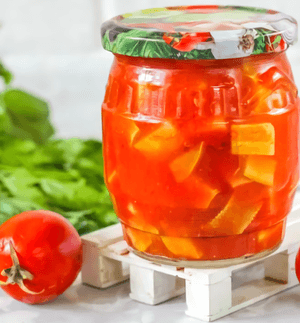Eggplants for the winter
Preserve the aroma and taste of summer with eggplants for the winter! Simple recipe with steps and tips. Create a variety of dishes in the cold season.




Recipe: Eggplants for the winter
Eggplants for the winter is a great way to preserve the delicate taste and aroma of this vegetable for many months. They can be used in various dishes, from appetizers to pasta sauces.
Ingredients
- 1.5 kg eggplants
- 2-3 onions
- 2-3 carrots
- 3-4 garlic cloves
- 500 ml tomato juice
- 100 ml vegetable oil
- 3 tablespoons vinegar
- Salt and pepper to taste
- Spices: bay leaf, clove, cumin (optional)
Cooking Steps
- Wash the eggplants, cut them into cubes or slices, sprinkle with salt, and let them sit for 30 minutes to remove bitterness.
- Finely chop the onion, grate the carrots, and mince the garlic.
- Rinse the eggplants, squeeze out excess liquid.
- Heat the oil in a deep skillet, sauté the onion until golden.
- Add the carrots and sauté for a few minutes.
- Add the eggplants and sauté until softened.
- Pour in the tomato juice, add the garlic, vinegar, spices, salt, and pepper.
- Simmer the mixture over low heat until it reaches a thick sauce consistency.
- Transfer the cooked eggplants into sterilized jars and seal.
Tips
- Add a little sugar to the recipe to balance the acidity of the tomato juice and enhance the sweetness of the eggplants.
- Experiment with adding different spices, such as oregano or basil, to give the eggplants a unique flavor.
- Before frying the eggplants, you can coat them in flour or starch for a crispy crust.
- For a more intense aroma, add some fresh mint or basil at the end of cooking.
- Eggplants for the winter can be used as a standalone dish or added to pasta, soups, and stews.
- Prepare eggplants for the winter in large batches and distribute them into jars in portion sizes for convenience.
- To maintain the freshness and color of the eggplants, add a little lemon juice during cooking.
- If you prefer softer eggplants, remove the skins before slicing.
- Try adding some olive oil before sealing the jars for additional flavor.
- For a spicier taste, add a pinch of ground red paprika or cayenne pepper.
- Experiment with different types of vinegar, such as apple cider or balsamic.
- Let the eggplants sit for a while before serving to allow the flavors to blend well.
Common Mistakes
- Improperly cutting the eggplants can result in uneven cooking.
- Excessive salt can make the eggplants too salty.
- Over-soaking the eggplants in salt can make them overly soft and lose their texture.
- Improper jar sealing or insufficient sterilization can lead to spoilage.
- Ignoring stirring during simmering can result in uneven distribution of flavors and aromas.
- Improperly cutting the eggplants can affect the dish's texture.
- Too little oil when frying can cause the eggplants to burn.
- Skipping the salting of the eggplants before cooking can retain bitterness in the dish.
- Excessive salt can overwhelm the natural taste of the eggplants.
- Insufficient simmering of the vegetables can result in a raw and under-flavored dish.
- Using inappropriate spices can affect the balance of the eggplants' taste.
- Over-mixing during simmering can soften the eggplants too much.
- Ensure that the jars and lids are well sterilized to avoid product spoilage.
- Ignoring the recipe and proportions can affect the final taste and texture of the dish.
- Over-soaking the eggplants in salt can make them overly soft and lose their characteristic taste.
Interesting Facts
- Eggplants were introduced into culinary practices in the Mediterranean and Central Asia.
- Eggplants are called by different names in different cultures, for example, in Italy - "melanzana," in Turkey - "patlıcan."
- Eggplants can absorb a lot of oil, so it's recommended to use a deep skillet when frying.
- Eggplants are rich in fiber and antioxidants, making them a healthy food choice.
- This recipe for eggplants for the winter will allow you to enjoy these vegetables even in the cold season.
- Eggplants were long considered unfit for consumption and were used as decorative plants.
- Eggplants are closely related to tomatoes and peppers.
- There are over 2000 different varieties of eggplants, differing in shape, color, and size.
- Eggplants are popular in many cuisines worldwide, from Mediterranean to Asian.
- In some countries, eggplants are considered a symbol of wealth and good luck.
- In Armenia, eggplants are used to prepare a dish called "patladjanov dolma" - stuffed eggplants that are baked or stewed.
- In Italy, eggplants are popular for making dishes such as melanzana parmigiana and lasagna.
- Eggplants are rich in fiber, vitamins, and minerals, making them beneficial for digestion and health.
- The color of eggplants can vary - from purple to white, as well as striped and green.
- Eggplants for the winter are a great way to preserve their taste and enjoy these vegetables throughout the year.




